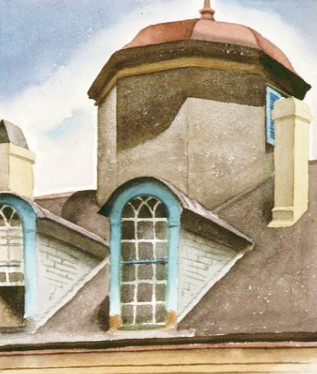
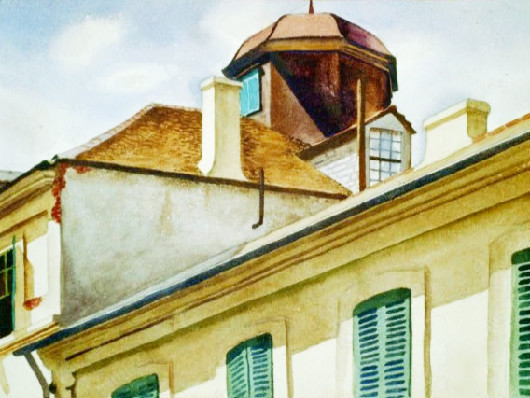
| The Girod House - "Napoleon House" 500 Chartres Street |
| Girod House, 1920's |
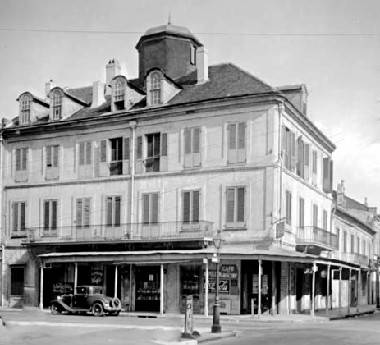
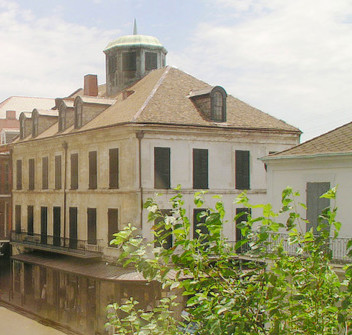
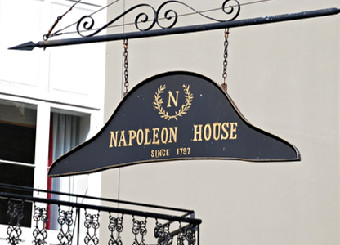
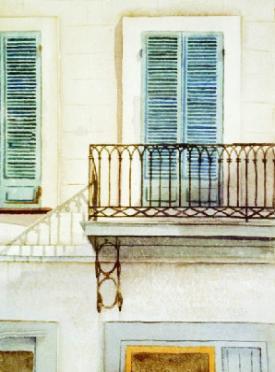
| The two images above and the one at the top of the page are copies of paintings of the Girod House done in the 1930's. |
| Girod House, 1990's |
| The link to this page is: http://www.thepastwhispers.com/NO_Girod_House.html Back to Old New Orleans Whispers - Home |
This building, typical of the Creole architecture of New Orleans, is best known as the
Napoleon House. It gained this name from a story that while the former Emperor was
prisoner on the Island of St. Helena, a group of his admirers in New Orleans, headed by
Mayor Nicolas Girod, planned his rescue and proposed to give him domicile in the city. To
that end, it's said that Mayor Girod offered his own home as a residence for Napoleon.
Although this story has no substantiation, it has persisted, with minor detail changes, since
the time of Mayor Girod himself. There are some indications that at least parts of the story
are true.
According to the most popular tale, Mayor Girod planned to engage the services of a
stalwart crew (including a pirate or two) and a swift sailing vessel, to secretly sail to the
island prison, surprise and overpower the guards, rescue Napoleon, and transport him to
New Orleans.
The scheme found backers, according to tradition, and the expedition was to be commanded
by Captain St. Ange Bossiere, whose ship was "a long, low, black, raking schooner named
the Seraphine." Through the years, Captain Bossiere's name has been substituted with
various others - such as Dominique You and Rene Beluche, and other members of Jean
Laffite's band. The story goes on to say that plans were ultimately completed, but on the
very day the ship was to set sail, word came that Napoleon had died.
One variation of this story - and the one believed by 19th century writer/historian Henry
Castellanos to be correct - goes like this: When Napoleon escaped from Elba in 1815, the
news reached New Orleans at a time the leading citizens were witnessing a performance in
the St. Philip Street theatre. Wildest enthusiasm greeted this announcement, made from the
stage, and the entire audience filed from the theatre and gathered with many others at
Jackson Square. The impression then was that Napoleon would desert France and seek
refuge in America and that, in all probability, New Orleans would be his port of entry. Nicolas
Girod, who was mayor at this time, is said to have made a speech in which he promised, if
Bonaparte would come to New Orleans, he would place his own residence at the disposal of
the former Emperor.
The Girod or Napoleon House was owned for many years by members of the Girod family.
The exact date of construction is unclear, but records prove that it existed (as a two-story
dwelling only) in 1798, when it was sold by the heirs of Dona Angela Monget to Don Claudio
Francois Girod. It hasn't been determined when the third story was added and the
distinctive belvedere placed on the roof. In 1814, Claude Francois Girod died and the
property passed to his brother, Nicolas, then serving as the first elected mayor of the city.
The home remained under his ownership until his death in 1841.
Since 1914, the old Girod mansion has been home to the Napoleon House Restaurant and
Bar, owned and operated by the Impastato family. Because of its unique ambiance, it's been
made famous by a host of artists and writers who have frequented the historic establishment
over the years. It's a popular stop for tourists and a favorite photo op.
-- Nancy
Napoleon House. It gained this name from a story that while the former Emperor was
prisoner on the Island of St. Helena, a group of his admirers in New Orleans, headed by
Mayor Nicolas Girod, planned his rescue and proposed to give him domicile in the city. To
that end, it's said that Mayor Girod offered his own home as a residence for Napoleon.
Although this story has no substantiation, it has persisted, with minor detail changes, since
the time of Mayor Girod himself. There are some indications that at least parts of the story
are true.
According to the most popular tale, Mayor Girod planned to engage the services of a
stalwart crew (including a pirate or two) and a swift sailing vessel, to secretly sail to the
island prison, surprise and overpower the guards, rescue Napoleon, and transport him to
New Orleans.
The scheme found backers, according to tradition, and the expedition was to be commanded
by Captain St. Ange Bossiere, whose ship was "a long, low, black, raking schooner named
the Seraphine." Through the years, Captain Bossiere's name has been substituted with
various others - such as Dominique You and Rene Beluche, and other members of Jean
Laffite's band. The story goes on to say that plans were ultimately completed, but on the
very day the ship was to set sail, word came that Napoleon had died.
One variation of this story - and the one believed by 19th century writer/historian Henry
Castellanos to be correct - goes like this: When Napoleon escaped from Elba in 1815, the
news reached New Orleans at a time the leading citizens were witnessing a performance in
the St. Philip Street theatre. Wildest enthusiasm greeted this announcement, made from the
stage, and the entire audience filed from the theatre and gathered with many others at
Jackson Square. The impression then was that Napoleon would desert France and seek
refuge in America and that, in all probability, New Orleans would be his port of entry. Nicolas
Girod, who was mayor at this time, is said to have made a speech in which he promised, if
Bonaparte would come to New Orleans, he would place his own residence at the disposal of
the former Emperor.
The Girod or Napoleon House was owned for many years by members of the Girod family.
The exact date of construction is unclear, but records prove that it existed (as a two-story
dwelling only) in 1798, when it was sold by the heirs of Dona Angela Monget to Don Claudio
Francois Girod. It hasn't been determined when the third story was added and the
distinctive belvedere placed on the roof. In 1814, Claude Francois Girod died and the
property passed to his brother, Nicolas, then serving as the first elected mayor of the city.
The home remained under his ownership until his death in 1841.
Since 1914, the old Girod mansion has been home to the Napoleon House Restaurant and
Bar, owned and operated by the Impastato family. Because of its unique ambiance, it's been
made famous by a host of artists and writers who have frequented the historic establishment
over the years. It's a popular stop for tourists and a favorite photo op.
-- Nancy